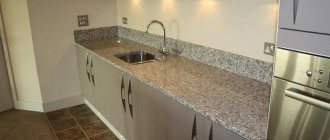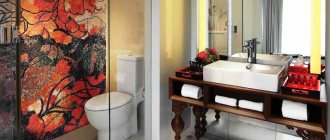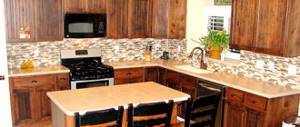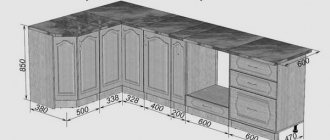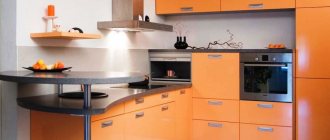There are several types of kitchen hoods, but if you need the most compact one, it is better to choose a built-in one. Built-in exhaust devices are practically invisible because they are hidden in the headset.
To find out whether you need a built-in model or whether it is better to pay attention to some other one, you need a clear understanding of the place of the hood in the kitchen space. If you consider equipment not only as an air purifier, but also as an attribute for interior decoration, then it is better to choose among dome, inclined, corner and island devices. If you want to emphasize the furniture and think that household equipment is easier to hide than to fit into the decor, a built-in kitchen air purifier is the best solution.
To determine which built-in hood to choose, you should have an idea of what they are. This applies to both the type of installation and cleaning features, as well as technical characteristics. An important criterion is the cost of the equipment, which depends on the device model and the availability of additional functions. So that you can see the full picture, we suggest going into each aspect in more detail.
Operating principle of built-in hoods
Before moving on to describing the selection criteria, let’s consider the operating principle of the built-in hood. Let us immediately note that it is the same as in devices of other types, but this is even good, because if you change your mind about buying an integrated model, you don’t have to study this issue anymore.
There are two types of air purification modes - exhaust and recirculation. Until recently, this parameter was important when choosing equipment. The user had to decide in advance which technique was most suitable for him - flow or circulation. Modern exhaust devices can work in both modes, so you don’t have to rack your brains. The only thing you need to pay attention to is the performance of the equipment in each cycle, but this will be discussed below.
Air exhaust
When operating in exhaust mode, the built-in hood sucks in polluted air and fumes and removes them from the room. To run the equipment in a flow cycle, it is necessary to build an air duct.
To make an air outlet line, you can choose a corrugated or plastic box, which can be rectangular or round in cross-section. Which is better? It is difficult to answer this question unambiguously; we can only point out the pros and cons of each of them. The advantage of corrugation is its low price and ease of installation. The corrugated pipe bends easily, so it can be given any direction without compromising the integrity of the product. Simply put, you don’t have to cut the corrugation.
However, this type of highway has two significant drawbacks - difficulty in maintenance and additional noise. Since the surface of the corrugation resembles an accordion, dust and dirt collect in its folds, which are quite difficult to get rid of. In addition, when air passes at high speed, the pipe may make a rustling noise. It’s not a fact that a built-in corrugated hood will definitely rustle, but this happens quite often.
Such problems will not arise with an air duct made of a plastic box. The pipe has a smooth surface, so it is easy to clean from dirt and does not make noise. The disadvantage of a plastic line is the complexity of installation and higher cost.
To rotate the air duct, the pipe must be cut and connected using a special adapter. But it should be taken into account that the air exhaust line is installed once, so all the difficulties in work will be compensated by the attractive appearance and silent operation of the air duct. And to completely save yourself the hassle, you can entrust the installation to a specialist. The air duct at one end is connected to a special hole in the built-in hood, the other must be led into the ventilation shaft or through the wall to the street.
Recycling
The difference between a recirculation cycle and a flow cycle is that there is no need to lay an air duct. A recirculation hood works on a different principle: contaminated air is not removed from the room, but is cleaned in a carbon filter, after which it is returned back through special holes.
The advantage of using a built-in exhaust device in recirculation mode is obvious - there is no need for labor-intensive installation of the air duct, which means additional installation costs. The disadvantages include the need to purchase filters and lower (25-30%) productivity compared to the exhaust mode.
If possible and conditions allow, it is better to install a built-in hood in the exhaust mode, and use the equipment as needed in the recirculation cycle. For example, if there are unpleasant odors coming from the ventilation shaft due to reverse draft, you can switch to the recirculation mode.
Considering the principle of operation of the built-in device, it should be noted that the air is purified not only from odors, but also from fatty particles. This work is performed by a grease filter, which is a metal grid with many small holes and is installed directly above the cooking area. The task of the grease filter element is to prevent fat particles from penetrating into the device, where they can settle on the motor and damage it. That is why the process is divided into 2 stages - cleaning in a grease removal cartridge and cleaning in a carbon cartridge.
Equipment design
What types of hoods are there for kitchens without an air duct? The model range is diverse and includes equipment with different functional contents. But the operating principle is the same everywhere. They consist of a fan, filters and a motor that powers them. This is the frame. The air is drawn in and passes through the cleaning modules. They retain and cleanse it from burning and unpleasant odors.
But the output of this air depends on the operating mode of the equipment: exhaust or circulation. However, new models often provide combined operation in both of these modes, based on the needs of the owner. What are the differences between these modes?
- Exhaust – provides for the removal of polluted air into ventilation or to the street, if there is none. The outlet for the hood in the kitchen is made by a special air duct connected with a clamp to the device.
Modern device for removing unpleasant odors
- Circulating – based on air filtration. It does not extend beyond the boundaries of the room. Kitchen hoods without exhaust are equipped with several levels of purification that allow air to pass through and use special openings to return it to the room.
Embedding types
Now that you know how a built-in hood works, you can move on to considering the characteristics that influence the choice of equipment. Let's start with the type of installation, because this criterion affects the possibility of installing equipment in a particular location.
The type of built-in device also determines its cost and ease of use. You need to think carefully about which technique will be most convenient for you.
Cabinet installation
The first type of built-in kitchen air purifiers are devices that are integrated into the kitchen unit. The device is installed in a wall cabinet, so it is almost completely hidden from the eye of the observer. Only the control panel remains visible - a low shell on which the mode selection buttons are located.
The grease filter, although not hidden in the cabinet, is not noticeable due to the fact that it is located above the hob, and you need to bend over to see it. The equipment is attached to the side walls of the cabinet, and the air duct (if the device will operate in exhaust mode) is passed through a hole pre-made in the lid.
It is better to entrust the installation of a hood built into a cabinet to a specialist, but if you decide to install the equipment yourself, you should know the installation rules. If you mount equipment above a gas hob, the distance from the grease filter to the cooking surface should be 75-85 cm, if above an electric one - 65-75 cm. If installed above the limit value, the device will work ineffectively, below it will interfere, and in the worst case under the influence of high temperatures the housing will melt.
The kitchen air purifier must be installed according to the markings, which are made in such a way that the axis of the device coincides with the axis of the hob. Otherwise, one of the edges will not be covered by the exhaust hood, and the fumes will not be completely captured.
Built-in countertop
Until recently, in-cabinet hoods were the only type of integrated kitchen air purifier. But the situation has changed, and for several years now there have been devices built into countertops on the market.
The equipment is installed behind the hob and, when active, is located perpendicular to the cooking plane. Since the appliances built into the countertop are located in close proximity to the burners, the fumes do not have time to disperse throughout the kitchen and are completely captured. The main thing is to choose the right mode.
In the inactive state, the device slides deep into the headset, like a cabinet drawer, only not horizontally, but vertically. Exhaust devices built into the countertop operate in exhaust and recirculation mode. To operate in a flow cycle, the air duct can be taken out to the street at the bottom of the wall or raised from the bottom up to the ventilation shaft. The latter option is less aesthetically pleasing, so the highway often has to be “sewn up” using decorative panels. The extractor units built into the countertop are designed for ultra-modern interiors and emphasize the user's commitment to the world of high technology.
Installation Rules
The installation requirements for the hood are the same for all types of models. Since the device is an electrical device that collects grease and moisture, a breakdown of current may occur through the housing of the equipment. To protect yourself during installation, you must properly ground the hood.
Typically, modern houses are equipped with a grounding loop and there should be no problems in this regard: you can insert the plug into the socket and the device is ready for use. If such a circuit does not exist, it is necessary to make it. Under no circumstances should you connect the grounding wire to pipes or radiators, as not only family members, but also neighbors may be injured if they receive an electric discharge through the risers.
In order to ground the device, a three-core wire with a cross-section of 2.5 square meters should be connected. mm to the electrical panel. Then find the pipe (solid neutral) from which the bundle of wires comes out, and connect your wire to it. Its end must be stripped.
Before purchasing a hood, you need to measure the cooking surface of the kitchen stove - length and width. For the device, these dimensions should be larger or, in extreme cases, the same. A hood with a smaller area will not cope with high-quality removal of polluted air.
Another rule that you need to remember when installing a hood is maintaining the distance from the surface of the stove to the appliance. The height above electric and induction stoves should be 65-75 cm, above gas stoves - at least 80 cm. If these parameters are not taken into account, inconvenience in working at the stove or fire hazards may arise due to overheating of the device.
We recommend that you read: Ventilation in the bathroom and toilet
The device must be fastened to the wall firmly and reliably, otherwise the device may break and injure one of the family members. Therefore, when covering the walls with plasterboard during repairs, you need to strengthen the place and place wooden blocks in the intended area for attaching the hood.
Dimensions of built-in models
Dimensions are a very important criterion for choosing exhaust equipment. If you get the dimensions wrong, the device will either be too bulky or ineffective. What should be the dimensions of a built-in hood? The choice of device dimensions depends on the dimensional parameters of the hob. There is a rule: the width of the exhaust device should not be less than the width of the slab, otherwise, as in the case of equipment misalignment, the vapors around the perimeter will not be completely captured.
The dimensions of standard hobs with 4 burners are 50 x 50 or 60 x 60 cm, and since manufacturers produce hoods strictly for cooking equipment, finding a built-in appliance of such dimensions is not a problem. It’s not a problem to find equipment for small or large surfaces - 45 x 45, 90 x 90, 100 x 100, 120 x 120 cm. There is no need to buy a built-in appliance much larger than the stove - it will block other work areas and create discomfort for the owner.
Energy consumption
Hoods are not energy-consuming equipment, but when choosing equipment, you still need to pay attention to power. To be precise, you need to choose equipment based on performance and at the same time ensure that the engine power is as low as possible. In this case, the exhaust device will operate as quietly and economically as possible.
The performance of a kitchen air purifier depends on the size of the kitchen. Productivity is calculated as follows: it is necessary to multiply the volume of the room by the air renewal factor equal to 12. The power of exhaust equipment can vary from 100 to 500 W, while the performance of seemingly equally powerful devices may differ.
Pros and cons of a ductless hood
There are several important advantages to operating ductless units:
- When a ducted hood is turned off, the exhaust air has nowhere to go because the ventilation shaft is blocked. A recirculating hood does not require a pipe and does not in any way interfere with natural air exchange in the kitchen.
- Design and ease of installation. This hood can be easily attached and connected to an outlet on its own, and after installation there are no extra pipes in the kitchen. Instead, only one plane will be added, which, if chosen correctly, will fit perfectly into the interior.
- Easy to care and maintain. Carbon filters are easy to change within a few minutes, and coarse filters are washed with hot water and simple detergents (not abrasive).
- Purchase and installation will cost much less than equipping a system with an air duct.
Unfortunately, not a single barrel of honey is complete without a fly in the ointment, and there are still disadvantages in filtration devices for the kitchen:
- Carbon filters need to be changed regularly. The frequency of replacement will directly depend on the intensity of use of the exhaust system. Smoking in the kitchen also affects the rate at which filters become dirty. Typically, the filter is changed every few months, which leads to additional costs.
USEFUL INFORMATION: Stages and features of apartment renovation in new buildings from scratch
The manufacturer indicates recommendations on the frequency of filter replacement to ensure efficient operation of the device in the technical specifications of the product.
- It is a common belief that filtration systems do not remove air contaminants as effectively as ducted units. In practice, it all depends on the size of the kitchen and the frequency of use of the hood.
For most standard kitchens, a recirculating hood will be sufficient.
Modern design and colors
Color and design are an important characteristic of most hoods, but not built-in ones. It's easy to see why. The device is hidden behind the walls of the headset, so the design fades into the background.
You have to pay attention mainly to the style of the dashboard and the design of the visible part. You can purchase a stationary or slider built-in hood. The sliders look a little different and feature the ability to expand the suction area by extending the front part.
The control panel can be mechanical, electronic or touch. Exhaust devices of the first type are equipped with slide switches, the second - with buttons, the latter type has an absolutely disgusting surface on which pictograms are applied. The appearance of the control panel has a certain influence on the design of the equipment, but in general it is an attribute of ease of use.
Functions of modern built-in hoods
There are several types of functionality of built-in kitchen air purifiers:
modes associated with air purification; options that affect the comfortable use of the device; control functions; additional technical capabilities.
The first category includes, first of all, the ability to choose the speed on which the suction strength of vapor depends. There are built-in hoods with intensive mode for super-fast cleaning of a smoky kitchen. Many models have an anti-return valve that prevents air from the street or ventilation shaft from entering the kitchen.
Comfortable operation includes touch control, with which modes are selected by lightly touching the icons, as well as a remote control.
More expensive devices are equipped with airspace condition monitoring sensors. Such hoods are able to independently assess the degree of air pollution and automatically turn on at the desired speed. Additional functionality includes the presence of a timer, a digital display informing the user about the selected mode and the degree of filter contamination, and illumination of the work area.
What types of hoods are on sale?
According to the principle of operation, exhaust equipment can be divided into two categories:
- Flow hoods. They are also called tap-offs. This type of device discharges exhaust air into the home ventilation system or directly to the street through an air duct pipe. Moreover, it is possible to use an external outlet only if there is a special exhaust duct. If the hood is ducted into the ventilation system of a house with a common ventilation shaft, then the equipment most likely simply will not be able to function correctly, since old systems do not provide for such loads. For this reason, if you decide to install a vent hood in your apartment, the best solution would be to vent it to the outside.
- Recirculation hood. You can also hear names such as carbon, filtration, etc. A device of this type does not require the presence of an air duct. It collects polluted air, places it in an internal tank and cleans it using a filter system. Typically, such equipment involves two stages of purification. First, rough processing occurs, during which dirt, grease and soot are filtered out. The air is then cleaned of unpleasant odors and then returned to the room.
USEFUL INFORMATION: Decorative plates in the kitchen interior: how to decorate the wall above the dining table
Advantages of built-in hoods from Korting
There are more than a dozen well-known manufacturers of exhaust hoods, but few can boast such a wide range of built-in hoods as Korting. The manufacturer produces appliances for kitchens and hobs of any size, slider and stationary, light, dark and the color of stainless steel. Preference is given to more reliable mechanical and push-button controls.
Corting built-in hoods are universal because they operate in exhaust and recirculation modes, have a low noise level and bright illumination of the work area. Some models are equipped with two motors, which increases the efficiency of the equipment and reduces noise levels. Corting's built-in exhaust units are equipped with aluminum grease filters that do not rust and can be easily washed by hand or in the dishwasher. The equipment is built into a cabinet and takes up minimal space. The package includes instructions for installation and operation.
Order the Korting built-in hood in our online store. We work without intermediaries and sell high-quality and productive exhaust equipment at reasonable prices. We provide an official guarantee from the manufacturer and deliver household appliances to any location in Russia. For technical characteristics and descriptions of built-in Corting hoods, see the product cards.
